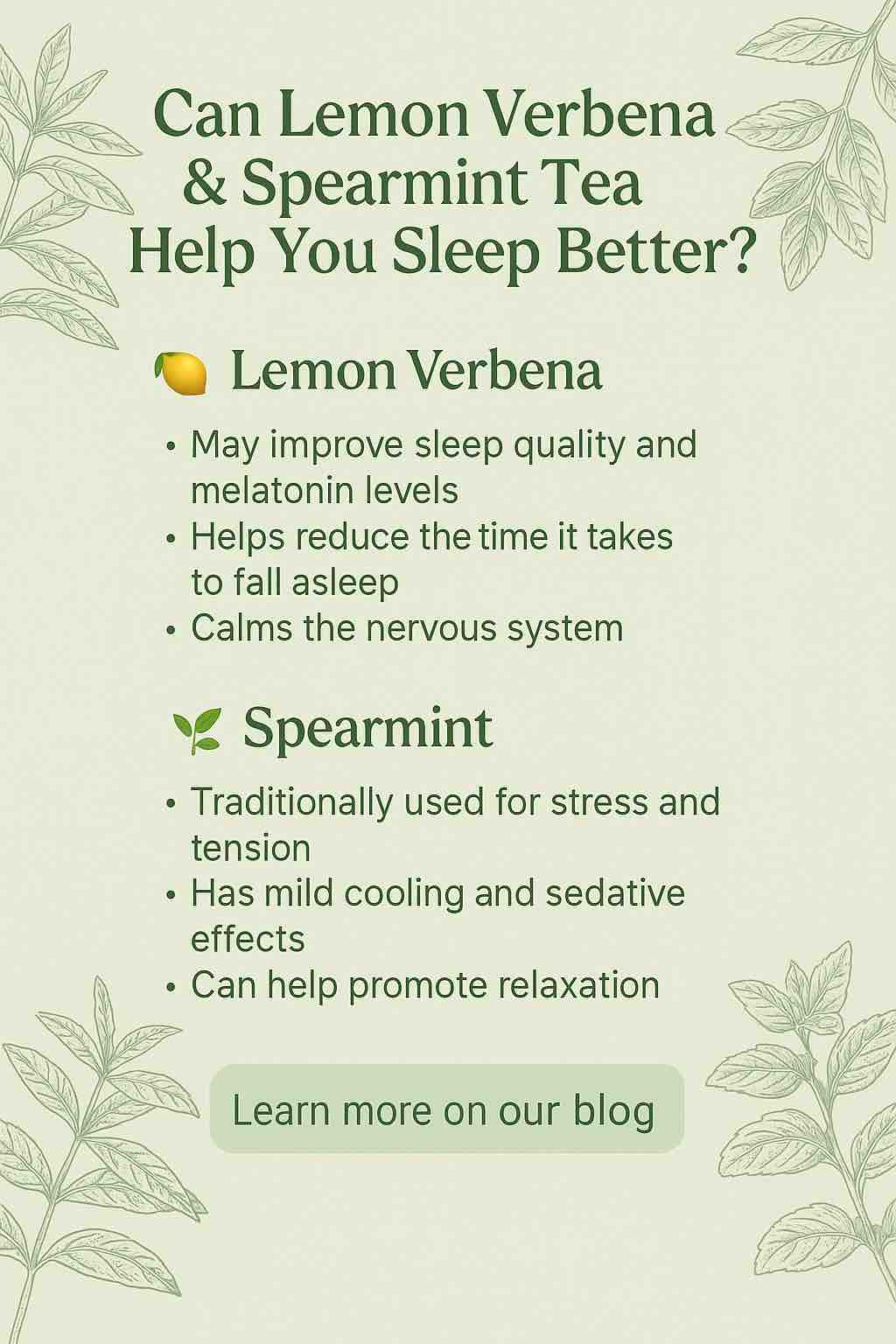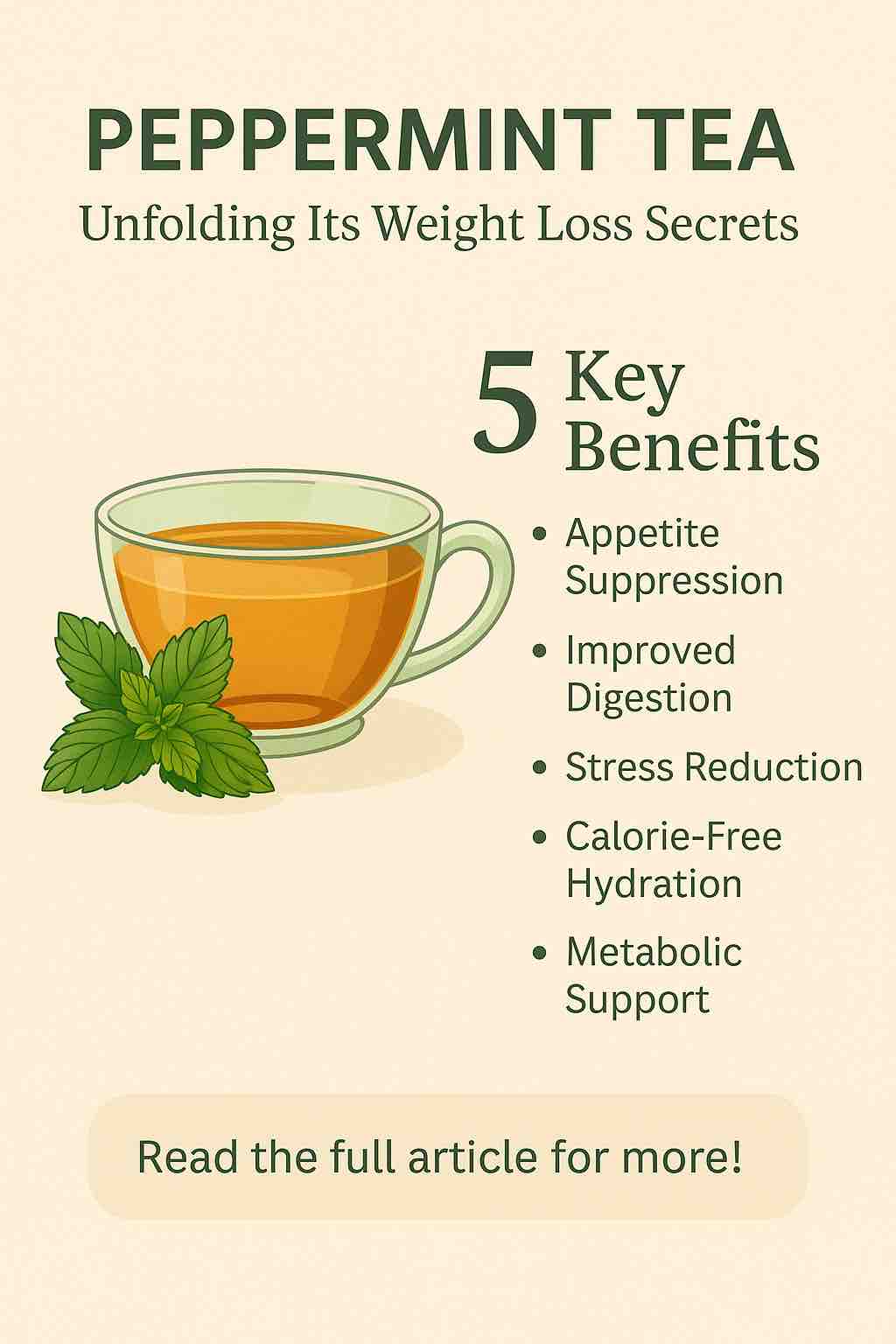
Do you find yourself tossing and turning at night, struggling to calm your racing mind or relax your body? You’re not alone. In our hyperconnected world, restful sleep often eludes even the most disciplined among us. But what if the key to a deeper, more peaceful slumber lies in something as simple as a cup of herbal tea?
Today, we’re exploring two aromatic powerhouses—lemon verbena and spearmint—that, when combined, offer a soothing, natural path to better sleep. Backed by both tradition and science, these herbs bring more than just great flavor to your evening ritual—they bring restoration.
🌿 Why Herbal Teas for Sleep?
Herbal teas have long been used as gentle remedies for calming the mind and easing the body into rest. Unlike pharmaceutical sleep aids, which can be habit-forming or leave you groggy, herbal infusions tend to work in harmony with the body’s natural rhythms. They can support sleep onset, quality, and duration—without side effects.
Two herbs in particular—lemon verbena and spearmint—stand out not just for their delightful flavor profiles, but for their science-backed benefits in promoting relaxation and restful sleep.
🍋 Lemon Verbena: The Sleep-Supporting Citrus Wonder
Lemon verbena (Aloysia citrodora) is a lemon-scented herb native to South America. Revered for its uplifting aroma and calming effects, it has been used in traditional medicine to ease anxiety, digestive discomfort, and insomnia.
🌿 What the Science Says:
In 2024, a double-blind, placebo-controlled clinical trial studied 71 adults with mild sleep disturbances. The participants took 400 mg of RelaxPLX, a lemon verbena extract, daily for 90 days.
Key findings:
- Sleep quality significantly improved as measured by the Pittsburgh Sleep Quality Index (PSQI).
- Melatonin levels increased by 14% in participants taking lemon verbena, helping regulate the sleep-wake cycle.
- Participants reported falling asleep faster and waking up less during the night.
This effect is believed to stem from lemon verbena’s rich polyphenol content, especially verbascoside, which appears to interact with GABA receptors in the brain—similar to how anti-anxiety medications work, but gently and naturally.
Other benefits: Lemon verbena is also a mild digestive aid and anti-inflammatory, which can further enhance sleep by reducing physical discomfort.
🌱 Spearmint: A Cooling Calm for the Nervous System
Spearmint (Mentha spicata) is another soothing herb often used in bedtime teas. With its sweet, minty taste and refreshing aroma, spearmint is more than just a flavor enhancer—it plays a role in mental and physical relaxation.
🌿 Traditional Use and Current Understanding:
While scientific studies specifically linking spearmint to improved sleep are still limited, spearmint is widely used for its:
- Mild sedative effects: Menthol, a key compound in spearmint, can produce a cooling sensation that helps calm nerves and muscles.
- Digestive support: Spearmint helps relieve bloating and indigestion, which can otherwise disrupt sleep.
- Stress reduction: The scent of spearmint has been shown to lower perceived stress and promote a relaxed state, ideal for transitioning into rest.
Spearmint also blends beautifully with lemon verbena, creating a tea that is not just functional but delicious.
☕ 5 Soothing Lemon Verbena and Spearmint Recipes for Better Sleep
Ready to put these powerful herbs to work? Here are five creative and calming ways to incorporate lemon verbena and spearmint into your nighttime ritual:
1. Classic Lemon Verbena-Spearmint Tea
- 1 tsp dried lemon verbena
- 1 tsp dried spearmint
- 1 cup boiling water
Steep for 5–7 minutes, strain, and enjoy warm before bed. Simple, fragrant, and effective.
2. Serene Sleep Herbal Elixir
- 1 tbsp lemon verbena
- 1 tbsp spearmint
- 1 tbsp chamomile flowers
- 1 tsp lavender buds
Mix and store in an airtight container. Steep 1–2 tsp of the blend in hot water for 10 minutes. This floral, calming blend is ideal for nights when anxiety is keeping you awake.
3. Lemon Verbena-Spearmint Iced Tea Cooler
- 2 tsp each of lemon verbena and spearmint
- 1 cup hot water
- Fresh lemon juice (optional)
- Ice cubes
Steep, cool, and serve over ice with a splash of lemon. A relaxing way to wind down after a hot day, especially in summer.
4. DIY Sleep Balm (Aromatic Topical Aid)
- 1 tbsp beeswax pellets
- 2 tbsp coconut oil
- 10 drops lemon verbena essential oil
- 10 drops spearmint essential oil
Melt beeswax in a double boiler, stir in coconut oil, and then add the essential oils. Let cool and solidify. Rub a small amount on your wrists, temples, or neck before bed for an aromatic, grounding experience.
5. Lemon Verbena-Spearmint Sleep Potpourri
Combine:
- 1 tbsp dried lemon verbena
- 1 tbsp dried spearmint
- 2–3 drops of each essential oil
Place in a sachet near your pillow or on your nightstand. As you breathe in the calming scents, your body will naturally begin to unwind.
🌙 Building a Bedtime Ritual with Herbs
Creating a sleep-friendly environment is about more than just drinking a cup of tea—it’s about building a consistent ritual that signals to your body it’s time to slow down. A warm cup of lemon verbena and spearmint tea can become the anchor of that ritual, supported by low lighting, relaxing music, and quiet reflection.
Consistency is key. Herbal remedies typically work best over time, so try to incorporate these teas or balms into your routine nightly for several weeks.
💬 Final Thoughts: Let Nature Guide You to Sleep
As the latest research continues to affirm what herbalists have known for centuries, it’s clear that the path to peaceful sleep doesn’t have to be paved with prescriptions. With lemon verbena and spearmint, you have nature’s gentle remedy at your fingertips—fragrant, flavorful, and effective.
So tonight, steep yourself a cup. Inhale deeply. Sip slowly. Let the herbs work their quiet magic as you ease into rest.
Sweet dreams. 🌿💤
💤 FAQs: Lemon Verbena & Spearmint for Better Sleep
1. Can lemon verbena really help me sleep better?
Yes. A 2024 clinical study confirmed that lemon verbena extract (400 mg/day) improved sleep quality, reduced sleep latency (time to fall asleep), and increased melatonin levels. It works by calming the nervous system, partly through GABA receptor modulation.
2. Is spearmint effective for sleep or just flavor?
While spearmint hasn’t been studied as directly for sleep as lemon verbena, it has traditional use in reducing stress and tension. Its cooling menthol content can promote relaxation, relieve digestive discomfort, and complement other calming herbs in sleep blends.
3. Can I drink lemon verbena and spearmint tea every night?
Absolutely. Both herbs are gentle and non-habit forming. A nightly cup can become part of a healthy, consistent bedtime routine. If you’re pregnant or on medication, check with your healthcare provider first.
4. When should I drink herbal tea for best sleep results?
For optimal effect, drink your lemon verbena-spearmint tea 30 to 60 minutes before bed. This gives your body time to absorb the herbs and ease into relaxation.
5. Can I mix these herbs with other ingredients like chamomile or lavender?
Yes. Lemon verbena and spearmint pair well with other calming herbs like chamomile, lavender, passionflower, or lemon balm, creating synergistic blends that enhance relaxation and promote better sleep.
6. Are there any side effects or precautions?
Both herbs are generally safe in moderate amounts. However:
- Lemon verbena may cause irritation in very high doses for some people.
- Spearmint should be used cautiously by those with acid reflux, as it may relax the esophageal sphincter.
Always consult a doctor if you’re pregnant, nursing, or on medications.
7. Can I use fresh herbs instead of dried?
Yes. Fresh herbs can be even more aromatic. Use 2–3 times more fresh herb than dried when making tea (e.g., 2–3 tsp fresh instead of 1 tsp dried).
8. Where can I buy lemon verbena and spearmint?
You can find both dried and fresh versions at health food stores, herbal apothecaries, online retailers (like Mountain Rose Herbs, Starwest Botanicals), or even grow them in your garden or on a windowsill.
9. What’s the difference between lemon verbena and lemon balm?
Though they share a lemony aroma and are both calming herbs, lemon verbena is more citrusy and uplifting, while lemon balm (Melissa officinalis) has a milder, more sedative effect. They can be used together or interchangeably depending on flavor and effect preference.
10. How long until I notice the benefits?
Some people feel calmer after just one cup. However, the most noticeable sleep improvements tend to come with consistent use over 2–4 weeks, especially with lemon verbena, which has been shown to work best over time.













